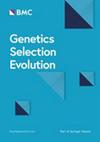基于生物安全的水产养殖育种计划中克服环境相互作用的基因型的基因组选择策略
IF 3.1
1区 农林科学
Q1 AGRICULTURE, DAIRY & ANIMAL SCIENCE
引用次数: 0
摘要
以家庭为基础的选择育种计划通常在水产养殖中采用家庭之间和家庭内部的选择。然而,与非生物安全育种方案(NBS)相比,采用基于生物安全的育种方案(BS)时,由于环境相互作用(G × E)存在基因型,这些方案的遗传增益可能会降低。幸运的是,基因组选择通过考虑到家族内部的变异,显示出提高遗传增益的希望。随机模拟来评估遗传增益和G×E b趋势改善l .对虾、体重的基因分型结果考虑选择性策略测试组(TG)商业农场环境(CE),个人选择组的数量(SG)的基因在核育种中心(NE),和不同程度的G×E .遗传增益损失BS范围从9.4到38.9% pedigree-based选择和更明显的G×E强时,NE和CE之间体重的遗传相关性较低。基因组选择,特别是对表现优异的TG个体进行选择性基因分型,有效地抵消了遗传增益的损失。遗传相关性为0.8,每个候选家族中20个SG个体的基因分型获得了NBS观察到的93.2%的遗传增益。然而,当遗传相关性低于0.5时,每个家庭的基因型SG个体数量必须增加到50或更多。从20个基因型个体增加到50个基因型个体,遗传增益平均提高9.4%,但从50个基因型个体增加到80个基因型个体,遗传增益平均仅提高2.4%。此外,在30代选择中,遗传相关平均降低0.13,且遗传相关在代际间波动。基因组选择可以有效补偿因G × E而导致的遗传增益损失,但基因型SG个体数量和G × E水平显著影响基因组选择带来的额外遗传增益。以家庭为基础的BS选择性育种计划应监测G × E水平,并对每个候选家庭50个SG个体进行基因分型,以尽量减少由于G × E水平低而导致的遗传增益损失,除非证实G × E水平低。本文章由计算机程序翻译,如有差异,请以英文原文为准。
Genomic selection strategies to overcome genotype by environment interactions in biosecurity-based aquaculture breeding programs
Family-based selective breeding programs typically employ both between-family and within-family selection in aquaculture. However, these programs may exhibit a reduced genetic gain in the presence of a genotype by environment interactions (G × E) when employing biosecurity-based breeding schemes (BS), compared to non-biosecurity-based breeding schemes (NBS). Fortunately, genomic selection shows promise in improving genetic gain by taking within-family variance into account. Stochastic simulation was employed to evaluate genetic gain and G × E trends in BS for improving the body weight of L. vannamei, considering selective genotyping strategies for test group (TG) at a commercial farm environment (CE), the number individuals of the selection group (SG) genotyped at nucleus breeding center (NE), and varying levels of G × E. The loss of genetic gain in BS ranged from 9.4 to 38.9% in pedigree-based selection and was more pronounced when G × E was stronger, as quantified by a lower genetic correlation for body weight between NE and CE. Genomic selection, particularly with selective genotyping of TG individuals with extreme performance, effectively offset the loss of genetic gain. With a genetic correlation of 0.8, genotyping 20 SG individuals in each candidate family achieved 93.2% of the genetic gain observed for NBS. However, when the genetic correlation fell below 0.5, the number of genotyped SG individuals per family had to be increased to 50 or more. Genetic gain improved by on average 9.4% when the number of genotyped SG individuals rose from 20 to 50, but the increase in genetic gain averaged only 2.4% when expanding from 50 to 80 individuals genotyped. In addition, the genetic correlation decreased by on average 0.13 over 30 generations of selection when performing BS and the genetic correlation fluctuated across generations. Genomic selection can effectively compensate for the loss of genetic gain in BS due to G × E. However, the number of genotyped SG individuals and the level of G × E significantly affected the extra genetic gain from genomic selection. A family-based BS selective breeding program should monitor the level of G × E and genotyping 50 SG individuals per candidate family to minimize the loss of genetic gain due to G × E, unless the level of G × E is confirmed to be low.
求助全文
通过发布文献求助,成功后即可免费获取论文全文。
去求助
来源期刊

Genetics Selection Evolution
生物-奶制品与动物科学
CiteScore
6.50
自引率
9.80%
发文量
74
审稿时长
1 months
期刊介绍:
Genetics Selection Evolution invites basic, applied and methodological content that will aid the current understanding and the utilization of genetic variability in domestic animal species. Although the focus is on domestic animal species, research on other species is invited if it contributes to the understanding of the use of genetic variability in domestic animals. Genetics Selection Evolution publishes results from all levels of study, from the gene to the quantitative trait, from the individual to the population, the breed or the species. Contributions concerning both the biological approach, from molecular genetics to quantitative genetics, as well as the mathematical approach, from population genetics to statistics, are welcome. Specific areas of interest include but are not limited to: gene and QTL identification, mapping and characterization, analysis of new phenotypes, high-throughput SNP data analysis, functional genomics, cytogenetics, genetic diversity of populations and breeds, genetic evaluation, applied and experimental selection, genomic selection, selection efficiency, and statistical methodology for the genetic analysis of phenotypes with quantitative and mixed inheritance.
 求助内容:
求助内容: 应助结果提醒方式:
应助结果提醒方式:


